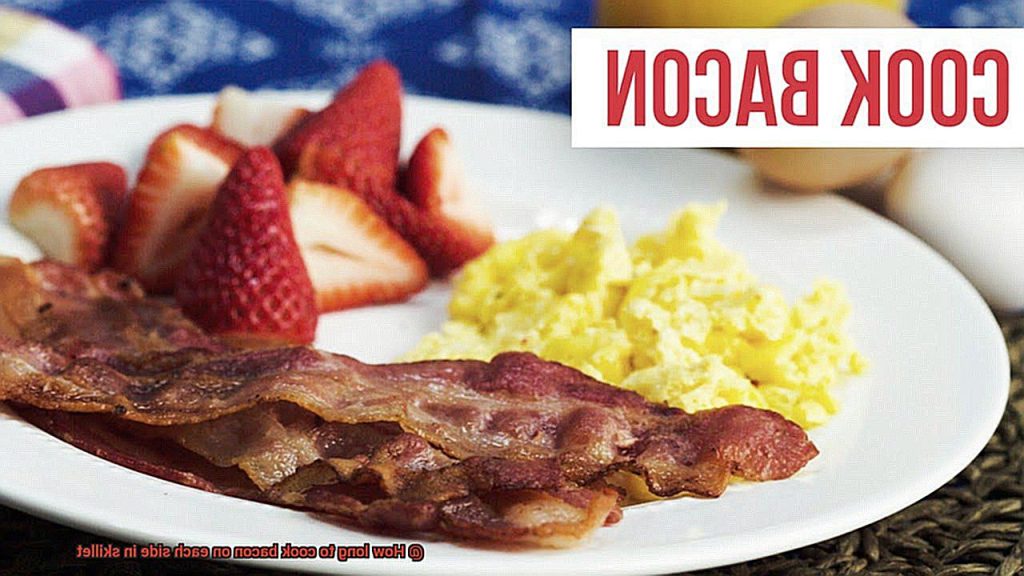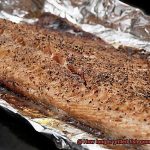Bacon – the undisputed king of breakfast foods. Its tantalizing aroma and mouth-watering flavor can make anyone’s day brighter. But let’s face it, cooking bacon can be a bit tricky. If you cook it for too long, it becomes burnt and tasteless, while undercooking leaves it chewy and unappetizing. So, what’s the secret to cooking perfect bacon? How long should you cook bacon on each side in a skillet?
Cooking bacon on a skillet is an age-old tradition that yields delicious results every time. However, several factors come into play when cooking bacon in a skillet – from the thickness of the slices to the temperature of the pan. The perfect balance of crispiness and juiciness requires careful attention to detail.
In this post, we’ll share all our tips and tricks to help you master the art of cooking bacon in a skillet. We’ll cover how long to cook bacon on each side in skillet for optimum results, what temperature works best, and how to avoid common mistakes that can ruin your meal. Whether you prefer your bacon crispy or chewy, we’ve got you covered.
So grab your skillet, turn up the heat and get ready to cook some amazing strips of sizzling bacon. By the end of this post, you’ll have all the knowledge you need to whip up perfectly cooked bacon that is crispy on the outside and juicy on the inside. Let’s get started.
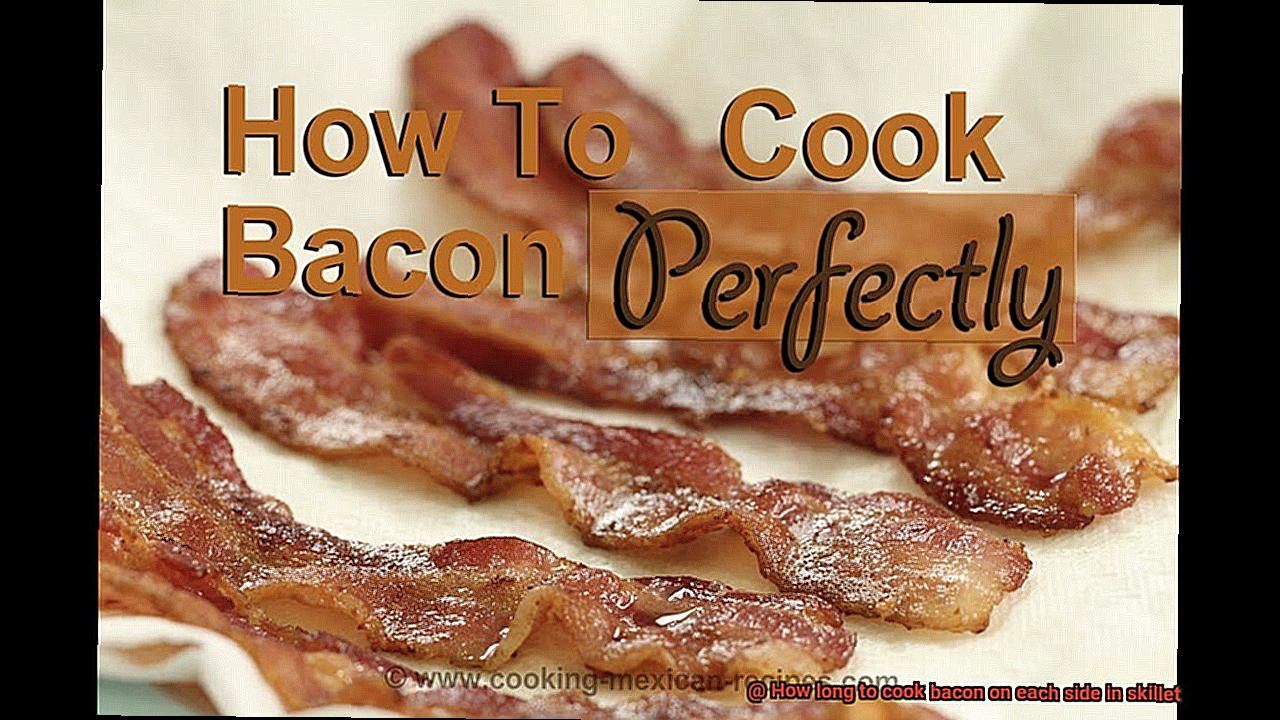
Contents
How to Choose the Right Type of Bacon for Skillet Cooking
When it comes to skillet cooking, choosing the right type of bacon is just as important as cooking it to perfection. Here are five things to consider when selecting the right type of bacon for your skillet:
Cut of Bacon
The cut of bacon determines the amount of fat and meat in each slice. Back bacon is a leaner option that’s cut from the loin, while streaky bacon comes from the belly and has more fat. American-style bacon is a broader cut that comes from both the belly and back. Consider the balance between fat and meat that you prefer in your bacon.
Thickness
The thickness of the bacon slices affects the texture and cooking time. Thin slices cook quickly and tend to be crispier, while thicker slices have a meatier texture and take longer to cook. Choose based on your personal preference and how you plan to use the bacon.
Smoked or Unsmoked
Smoked bacon has a rich, smoky flavor that can add depth to your dishes. Unsmoked bacon has a milder flavor profile and is a good choice if you want to control the seasoning of your dish.
Quality
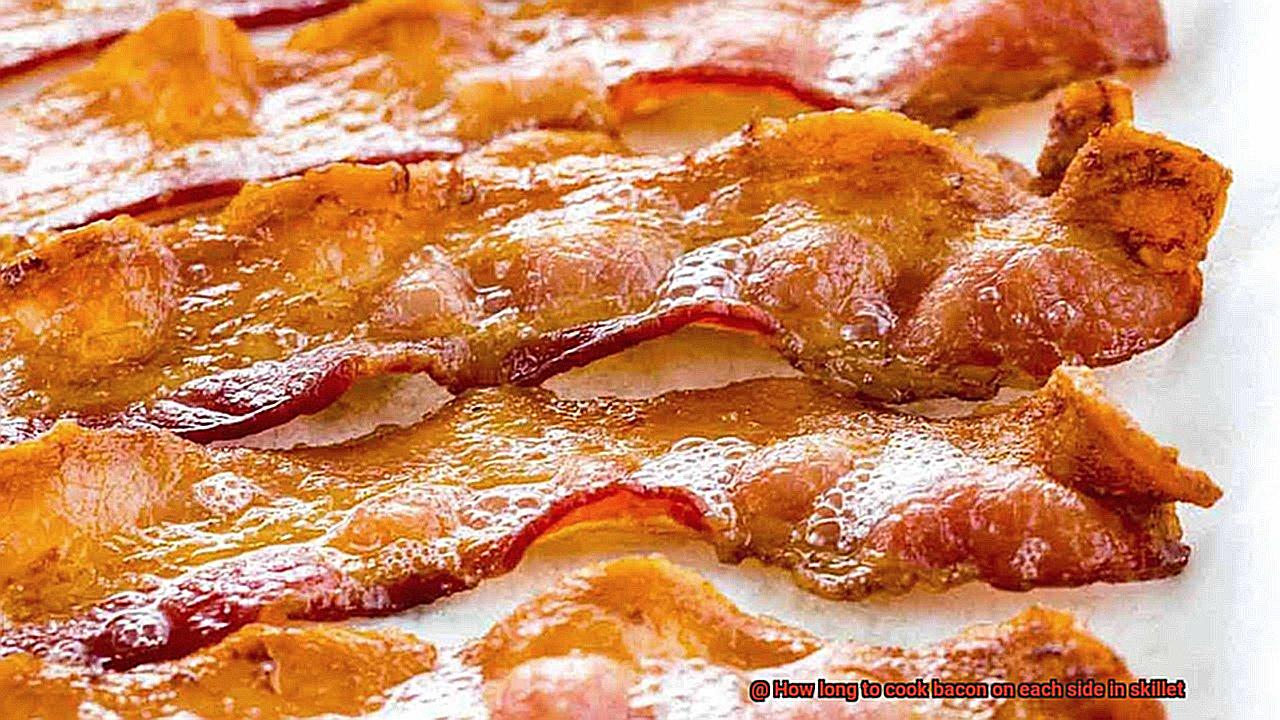
The quality of the bacon can make or break your meal. Look for high-quality bacon that has been raised without antibiotics or hormones, and has been humanely treated. This type of bacon will have better flavor and texture than lower quality options.
Flavored Bacon
If you’re feeling adventurous, try flavored bacon like peppered or garlic-infused varieties. These may require less seasoning when cooking, but be mindful that their flavors don’t overpower the dish.
Ultimately, choosing the right type of bacon for skillet cooking is a matter of personal preference and experimentation. By considering factors like cut, thickness, smoking method, quality, and flavoring, you can find the perfect match for your taste buds. So next time you’re at the grocery store, take a moment to consider your options and choose wisely.
Preparing the Bacon for Skillet Cooking
Bacon is a beloved breakfast staple that can take any dish to the next level. However, preparing it for skillet cooking can be a daunting task. Fear not, as we have gathered expert tips to help you achieve perfectly crispy bacon every time.
The first step in preparing bacon for skillet cooking is choosing the right type. Thick-cut bacon works best as it holds its shape and texture during cooking. Once you have your bacon, take it out of the fridge at least 15-20 minutes before cooking. This allows it to come to room temperature, ensuring even cooking and preventing curling.
After your bacon has reached room temperature, lay out the strips on a cutting board or plate and pat them dry with a paper towel. This removes excess moisture that can cause splattering while cooking. To prevent further curling, score the surface of the bacon with a knife or fork, creating small cuts that allow it to cook more evenly.
Now, it’s time to add some flavor. Spice up your bacon by seasoning it with your choice of spices or herbs before placing it in the skillet. Popular options include black pepper, brown sugar, garlic powder, or cayenne pepper.
When cooking your bacon, monitor it closely to prevent burning. Cook until it reaches your desired level of crispiness, then remove it from the skillet and place it on a paper towel-lined plate to absorb any excess grease.
Heat Settings for Perfectly Cooked Bacon in a Skillet
Look no further, as I have the inside scoop on how to achieve perfectly cooked bacon in a skillet. The key to achieving bacon nirvana lies in your heat settings. Cooking your bacon on medium-low to medium heat is crucial. This allows the bacon to cook slowly and evenly, rendering the fat without burning the meat. So, resist the urge to crank up the heat and be patient; trust me, it will pay off in the end.
Starting with a cold skillet is also essential. This helps prevent the bacon from curling up and promotes even cooking. Once your skillet is heated, add your bacon slices and let them cook undisturbed for 2-4 minutes on one side before flipping them over. The exact cooking time will depend on the thickness of your bacon slices and how crispy you like them.
Another crucial tip is to avoid overcrowding the skillet. Overcrowding can cause uneven cooking and lead to soggy bacon. If necessary, cook your bacon in batches, draining off excess grease between each batch.
But wait, there’s more. Adjusting the heat as needed throughout the cooking process is also important. If your bacon is cooking too quickly or starting to burn, lower the heat. If it’s taking too long to cook, increase the heat slightly. It’s all about finding that sweet spot between slow and steady cooking and avoiding burnt bacon.
In summary, cooking perfect bacon requires attention to detail when it comes to heat settings and techniques. Follow these expert tips for heat settings, and you’ll achieve perfectly cooked and crispy bacon every time.
To recap:
- Use medium-low to medium heat for slow and even cooking
- Start with a cold skillet to prevent curling and promote even cooking
- Don’t overcrowd your skillet – cook in batches if necessary
- Adjust heat as needed throughout the cooking process
The Basics of Cooking Bacon in a Skillet
Cooking bacon in a skillet may seem simple, but it takes some finesse to get that perfect texture. Fear not, we have the basics of cooking bacon in a skillet down to a science.
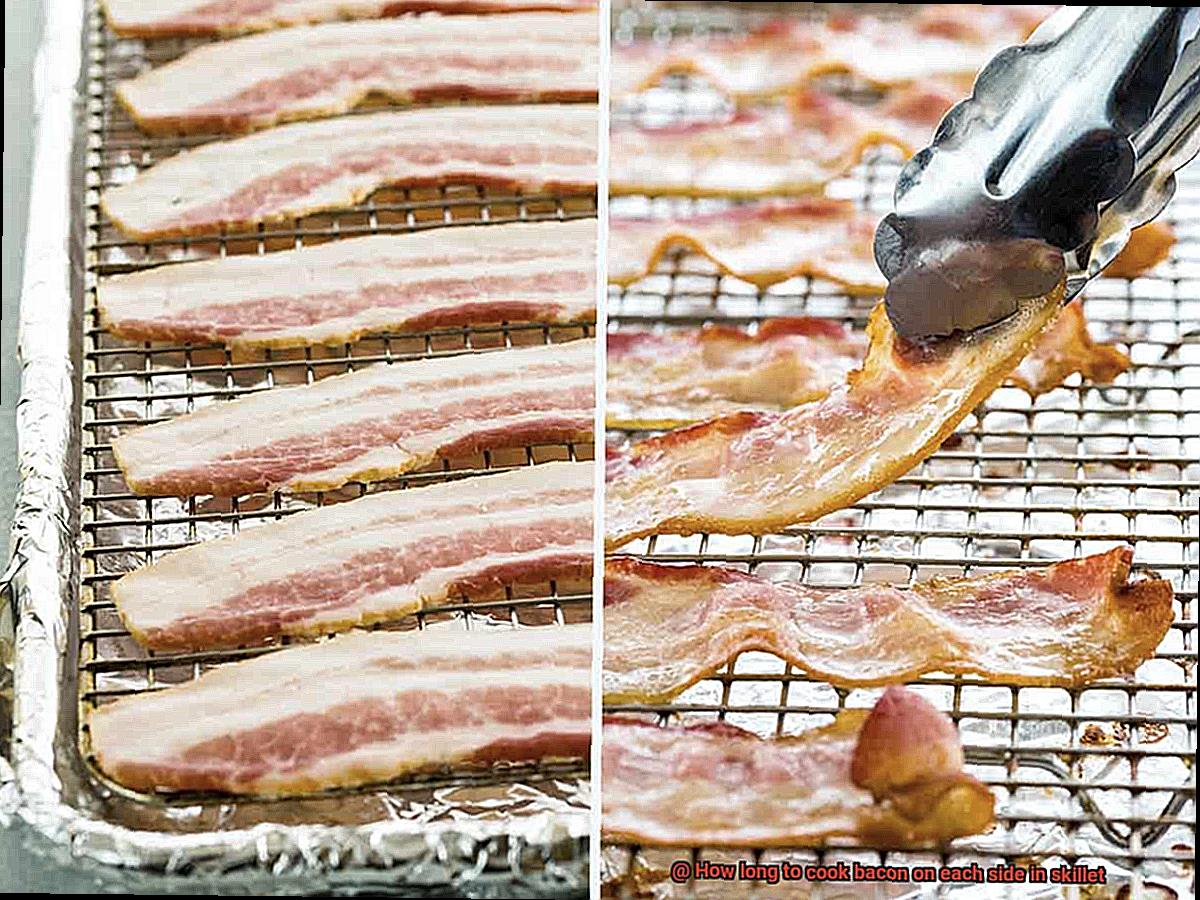
First, choose a skillet large enough to accommodate your bacon slices without overcrowding them. Overcrowding can cause uneven cooking and leave some pieces overcooked while others are still undercooked.
Next, set the stove to medium-low heat. It may be tempting to crank up the heat for faster cooking, but trust us – slow and steady is the key to success. This allows the bacon to cook slowly and evenly, resulting in that perfect crispiness.
Once your skillet is heated up, place the bacon slices carefully on the skillet, leaving some space between each slice. Cook for about 4-5 minutes on one side before flipping them over with tongs or a spatula.
When you flip the bacon over, you should see a beautiful golden-brown color on the cooked side. If not, continue cooking for another minute or so until it reaches your desired color. Repeat the process for the other side of the bacon, cooking for another 4-5 minutes until both sides are evenly cooked and crispy.
Remember that cooking times may vary depending on the thickness of your bacon slices and your personal preferences for how crispy you like your bacon. For best results, follow these basic guidelines for temperature and cooking time.
Here’s a quick summary:
- Choose a skillet large enough to fit your bacon slices without overcrowding.
- Set your stove to medium-low heat.
- Cook for 4-5 minutes on one side before flipping with tongs or a spatula.
- Cook for another 4-5 minutes until both sides are evenly cooked and crispy.
Tips for Achieving Crispy, Perfectly Cooked Bacon Every Time
Bacon is a beloved breakfast food that many people struggle to cook perfectly. Whether you prefer your bacon crispy or chewy, it can be challenging to get it just right. But with these tips for cooking bacon in a skillet, you can achieve crispy, perfectly cooked bacon every time.
Start with a Cold Skillet
One of the most important tips for cooking bacon in a skillet is to start with a cold pan. This prevents the bacon from sticking and allows it to cook evenly. Simply lay your bacon strips in the cold skillet and then turn on the heat.
Use a Quality Skillet
A good quality skillet is essential for cooking bacon. A heavy-bottomed cast iron skillet is ideal because it distributes heat evenly and retains heat well. This helps prevent the bacon from burning or sticking to the pan.
Cook Over Low to Medium-Low Heat
Cooking bacon over high heat can cause it to burn quickly and result in unevenly cooked strips. Instead, cook your bacon over low to medium-low heat. This allows the bacon to slowly render its fat and cook evenly without burning.
Flatten the Bacon
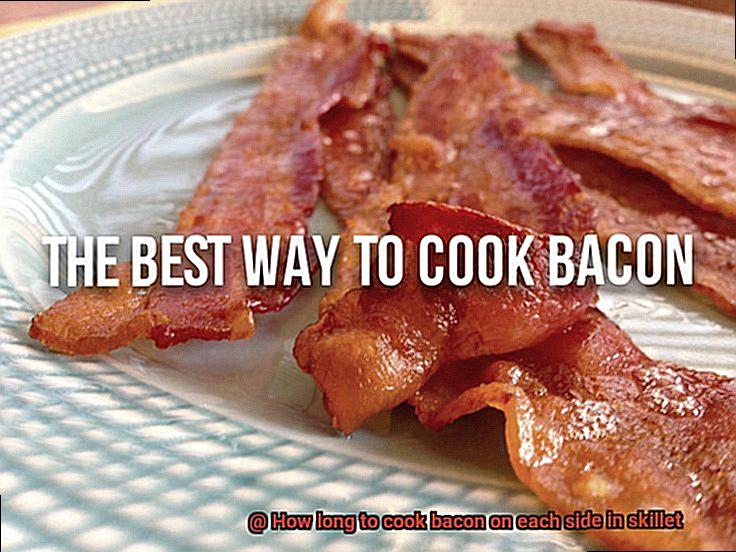
As the bacon cooks, it will start to curl up at the edges. To ensure that all parts of the bacon cook evenly, use tongs or a spatula to gently press down on the bacon strips and flatten them out.
Flip Regularly
Flipping your bacon regularly is another important step in achieving perfectly cooked, crispy bacon. This ensures that both sides are cooked evenly and prevents one side from becoming overcooked while the other side remains undercooked. A good rule of thumb is to flip the bacon every 2-3 minutes.
Remove Excess Grease
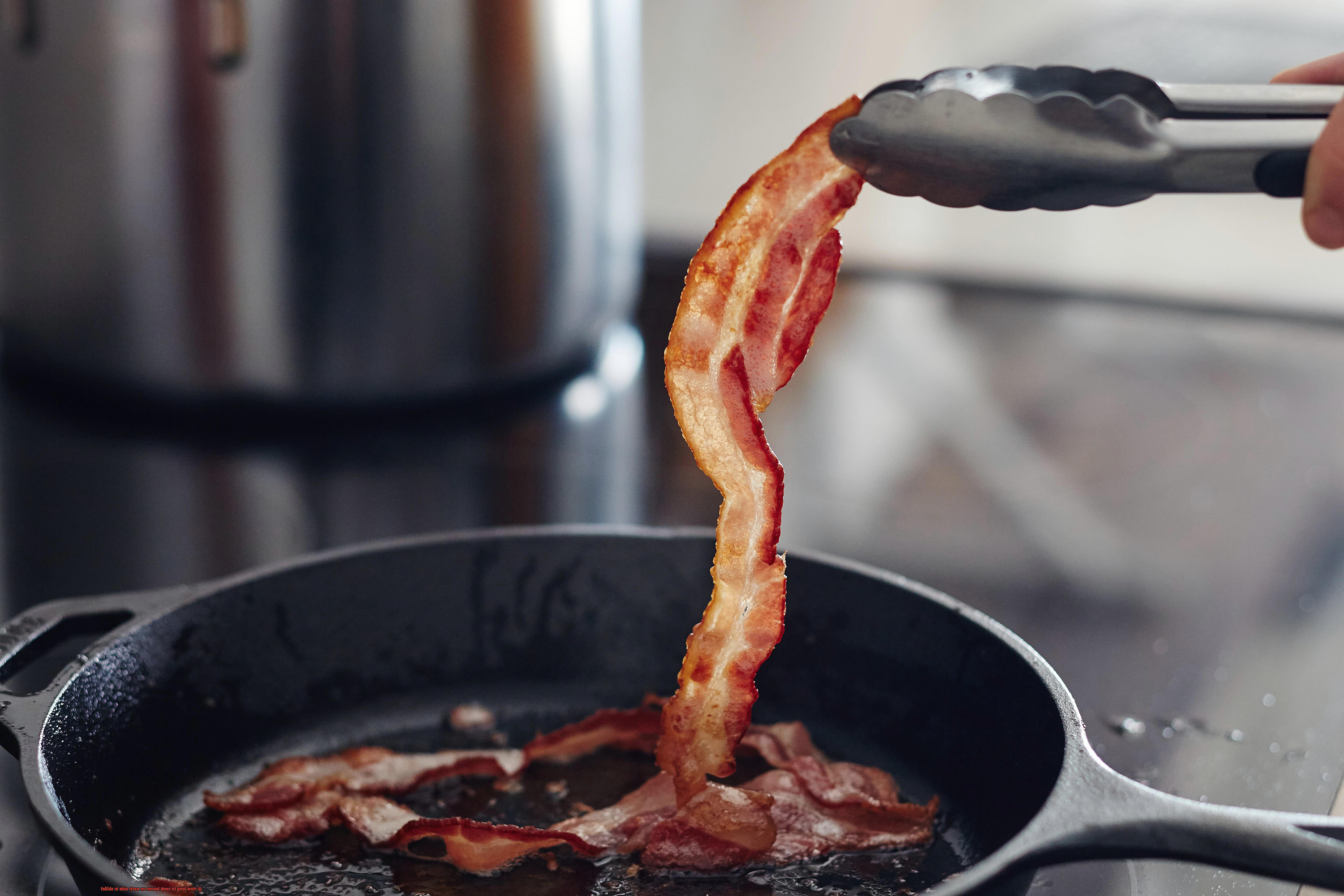
Removing excess grease from the skillet as you cook is key to preventing greasy, soggy bacon. You can use a spatula to remove any excess grease or place paper towels on a plate to absorb the excess grease as you remove each strip of bacon.
Let it Cool
Once your bacon is cooked to perfection, remove it from the skillet and place it on a paper towel-lined plate to absorb any excess grease. Allow it to cool for a few minutes before serving. This will ensure that any remaining grease is absorbed by the paper towel, preventing the bacon from becoming greasy.
How Long Should You Cook Bacon on Each Side in a Skillet?
It’s easy to overcook or undercook, resulting in dry and burnt or underwhelming and chewy bacon. But fear not, with our expert guidance, you’ll be able to cook the perfect bacon every time.
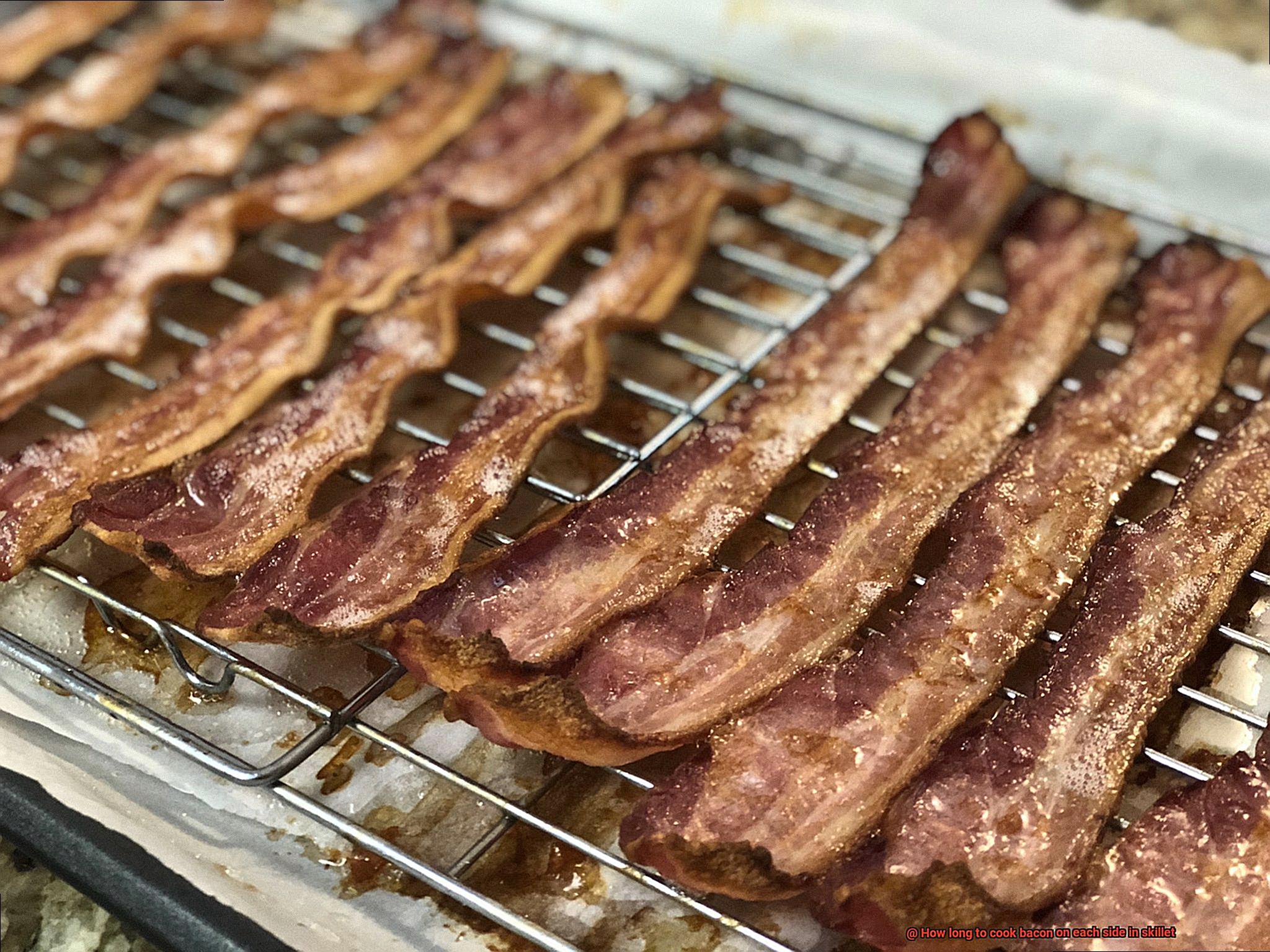
The key to cooking bacon in a skillet is timing. The general rule of thumb is to cook it for about 4-6 minutes per side. However, this can vary depending on the thickness of the slices and the heat level of your skillet.
Thin-sliced bacon cooks faster than thick-sliced bacon. So, if you’re using thin slices, you may only need to cook each side for 2-3 minutes. If you prefer thick slices, you may need to cook each side for 6-7 minutes. It’s crucial to adjust your cooking time based on the thickness of your bacon.
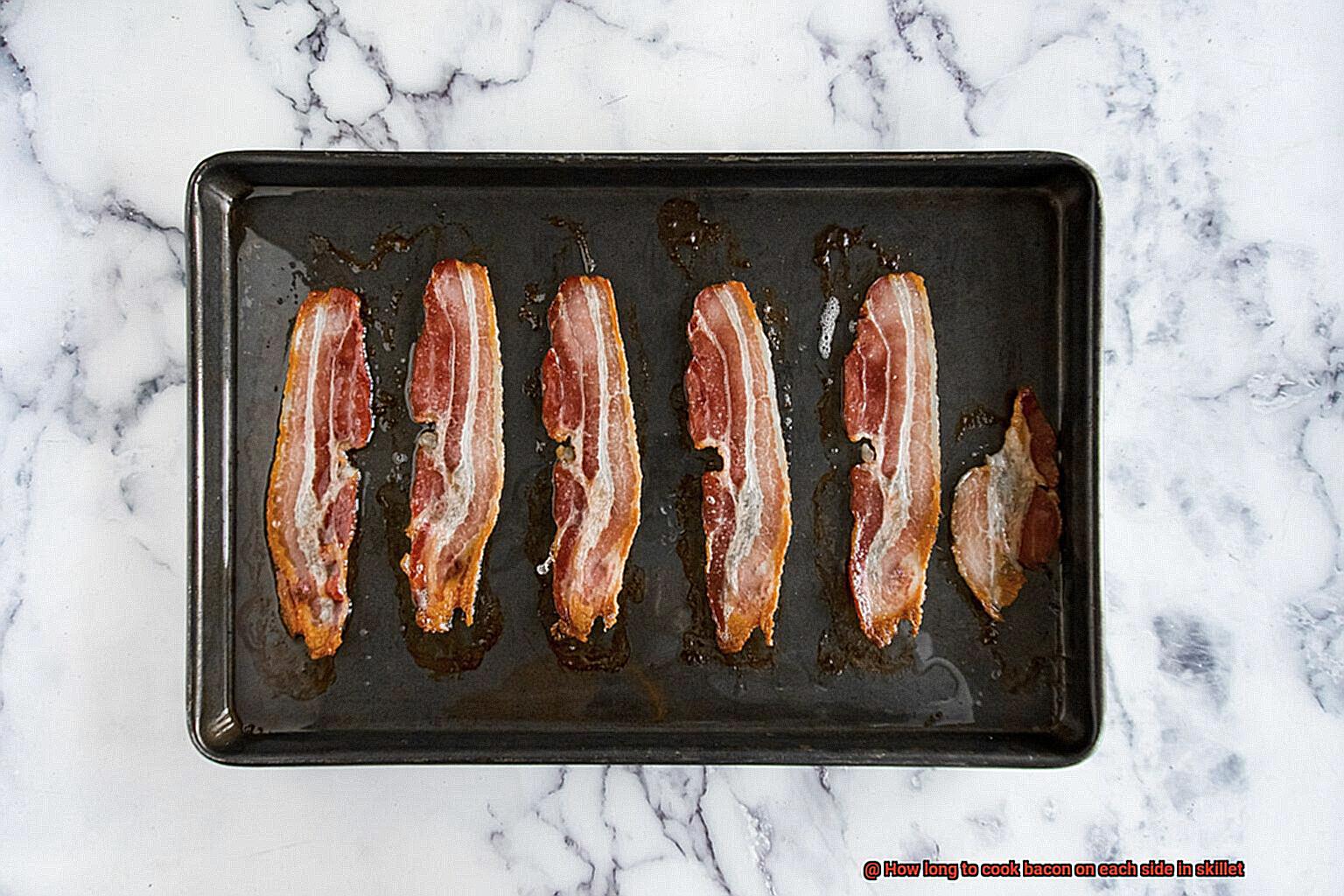
The heat level of your skillet also plays a significant role in cooking bacon. Start with medium heat and adjust as needed. Too much heat can cause the bacon to burn quickly, while too little heat will result in longer cooking times. Be patient and let the bacon cook at a steady pace.
To keep track of the cooking time, use a timer or watch the color of the bacon as it cooks. When it starts turning brown and crispy around the edges, it’s time to flip it over.
Proper preparation is just as important as timing when it comes to cooking bacon. Use a cold skillet and high-quality bacon. Flatten the bacon while cooking and flip regularly to ensure even cooking. Remove excess grease and let it cool before serving.
Common Mistakes to Avoid When Cooking Bacon in a Skillet
Fear not. As an expert in cooking bacon in a skillet, I’m here to share the common mistakes to avoid so you can cook up a delicious batch of perfectly crispy bacon.
Starting with a cold skillet is a big no-no. It’s tempting to throw your bacon into a cold skillet and let it heat up slowly, but this will result in unevenly cooked bacon. Instead, start with a hot skillet to ensure even cooking.
Overcrowding the skillet is another mistake people make. It’s understandable to want to cook as much bacon as possible at once, but this can lead to uneven cooking and prevent the bacon from crisping up properly. It’s best to cook bacon in batches or use a larger skillet if you need to cook a lot at once.
Flipping the bacon is crucial for even cooking on both sides. Don’t make the mistake of only cooking one side, as this can result in undercooked or burnt bacon on the other side. So, flip that bacon.
Cooking at too high of a heat is another common mistake that can lead to burnt bacon and uneven cooking. It’s best to cook at a medium heat and adjust as needed.
Finally, don’t forget to drain the grease. Bacon produces a lot of grease while cooking, which can lead to soggy bacon if not drained properly. Use tongs to remove the bacon from the skillet and place it on paper towels to absorb excess grease.
To sum it up, here are the common mistakes to avoid when cooking bacon in a skillet:
- Starting with a cold skillet
- Overcrowding the skillet
- Not flipping the bacon
- Cooking at too high of a heat
- Not draining the grease
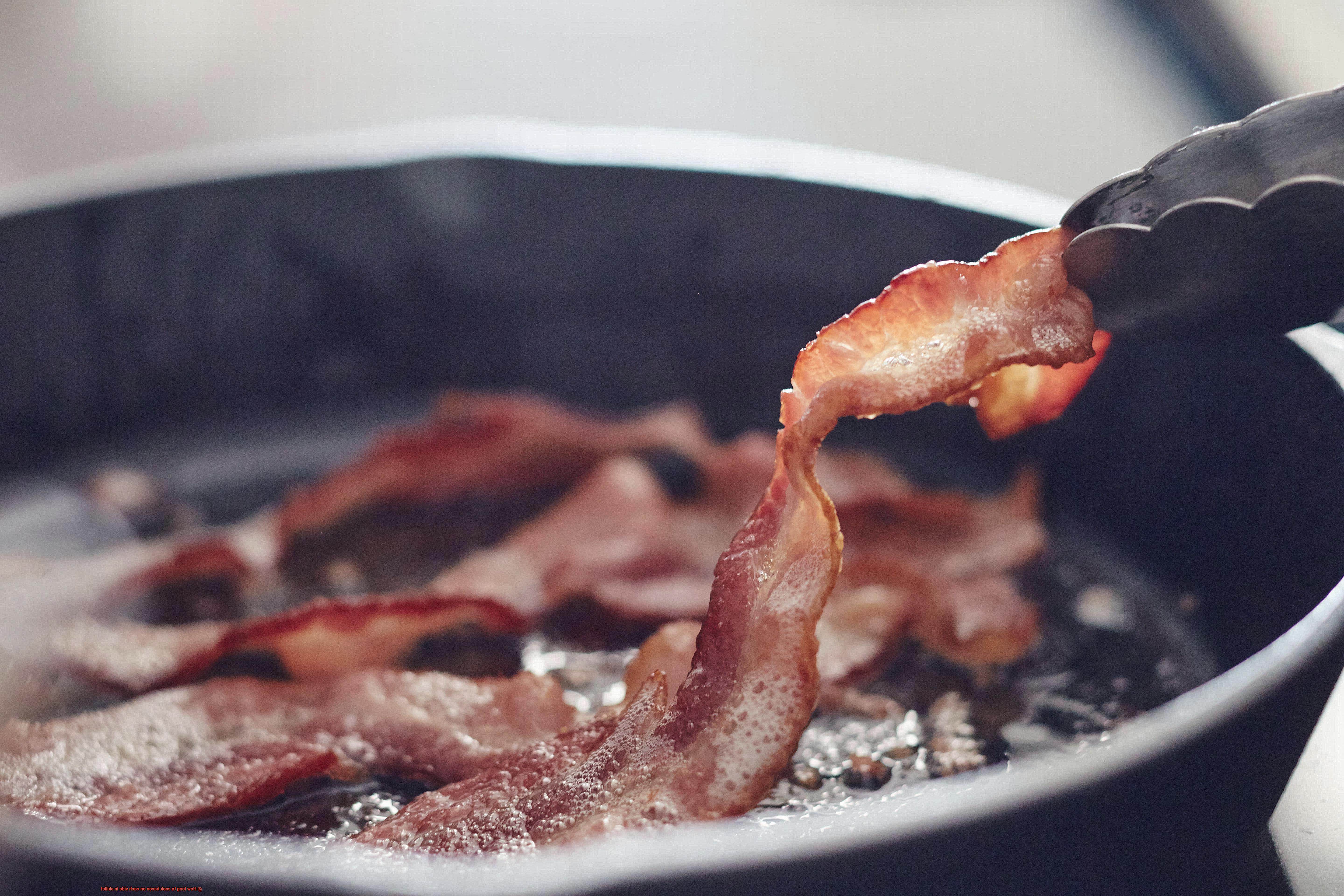
2guC4Badq2s” >
Conclusion
In the world of culinary arts, cooking bacon in a skillet is an art form that requires precision and patience. From selecting the right type of bacon to mastering the perfect heat settings, there are several factors that come into play when cooking this beloved breakfast staple.
To start, using quality bacon is key. Additionally, it’s important to begin with a cold skillet and cook over low to medium-low heat while flattening the bacon as it cooks. Regularly flipping the slices and draining excess grease can also make all the difference in achieving perfectly crispy and delicious bacon.
Timing is everything when it comes to cooking bacon in a skillet. For optimal results, cook each side for approximately 4-6 minutes depending on the thickness of your slices and skillet’s heat level. Remember that thin-sliced bacon cooks faster than thick-sliced varieties, so adjust your cooking time accordingly.
Avoiding common mistakes such as overcrowding your skillet or cooking at too high a heat can help you achieve mouth-watering results every time. With practice and attention to detail, you’ll soon be able to impress your loved ones with your culinary skills.
So next time you’re craving some sizzling strips of bacon for breakfast or brunch, remember these expert tips and tricks for cooking bacon in a skillet.

